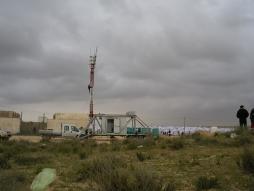Natural disasters and humanitarian crises can damage infrastructure, redistribute populations, and make it difficult for relief organizations to do their work; in these situations, mobile communications can be the best way to organize disaster relief efforts and provide early warning systems.
The GSMA has released finalists for the Global Mobile Awards (Editor's Disclosure: MobileActive's Katrin Verclas is a judge for the awards in the category focused on mobile programs for "Underserved Communities.")
The nominees in the "Best Use of Mobile in Emergency or Humanitarian Situations" struck us as particularly interesting. They demonstrate an interesting and varied use of mobile technology in an emergency. Here are a few.
Early Warning Systems and Recovery
Smart Communications: Using SMS to Strengthen Disaster Preparedness in Southern Leyte
A quick response to natural disasters can limit the death toll and minimize damage. Following the March 2011 Japanese earthquake, a tsunami alert was issued via SMS to the residents of Southern Leyte, Philippines, to give residents warning that a tsunami could hit their area. The early warning system, developed by Smart Communications, runs on a web-based group broadcast system called Infoboard, which can be programed to send out SMS alerts. Smart Communications provided mobile phones to the island's locally-based leaders of warning teams, and sent them SMS alerts to trigger a phone tree. The method combines mobile technology with the existing, community-based warning systems to reach the most people quickly and effectively.
NTT DOCOMO: Quick Recovery from the Japanese Earthquake and New Disaster Preparedness Measures
Communications can be affected following a disaster – roads can be damaged and landlines and cell phone towers can be broken. Following the destruction from the March 2011 Japanese earthquake, the Japanese telecommunications company NTT DOCOMO responded by creating communications solutions to work around destroyed and damanged telecommunication facilities.
The company provided 900 satellite phones to aid workers and constructed satellite-based service areas in the most affected regions, along with providing free battery recharging stations and chargers. While the company repaired mobile towers and landlines, the satellite phones helped aid workers maintain contact across the affected areas. The organization also built an online map so that users could log in and see when and where the service was restored in the most heavily hit areas.
In addition to building an emergency mobile communications service following the earthquake, NTT DOCOMO also developed an early earthquake alert system that sent out messages to notify users of expected tremors.
Flowminder.org: Analyzing Rapid Population Movements using Cellphone Data
A side effect of disasters can be the outbreak of disease and infection as water and sanitation points can be damaged and many different people are grouped together in close quarters. Rapid, unplanned population shifts can lead to disease outbreaks, such as the cholera outbreak in Haiti following the 2010 earthquake. A new program from Flowminder uses mobile date to predict where refugees are resettling, how many have resettled there, and then uses that data to predict areas that are vulnerable to disease outbreaks based on the population changes.
Using geolocation data from SIM cards on the Digicel network, researchers analyzed where populations were congregating in order to estimate trends. Following the Haitian earthquake, the researchers collected data from more than 1.9 million SIM cards, tracking how populations moved before the earthquake and what they did after the earthquake. The data can help aid workers see where populations shifts are occuring and target those areas for extra relief.
Mobile Money
United Bank Limited for UBL Omni Cash Disbursement Service
During a crisis, distributing money can be a challenge – paper money and checks can be lost, damaged, stolen, or forged, making it difficult to make sure that the right amounts of money are getting to the intended recipients who need it most. Mobile money transfers can reduce this risk, sending payments directly to users' phones. United Bank Limited's mobile money system issued prepaid cards with unique PINs in Pakistan twice following a humanitarian crisis and a natural disaster.
Cards were given to internally displaced people following fighting in 2009 that caused many Pakistanis to flee the Khyber Pakhtunkhw region, and after the 2010 flood which killed roughly 2000 people and left millions homeless. Card recipients could visit Omni distribution centers (there are roughly 7000 in Pakistan) where agents would exchange the mobile credits for cash, using a mobile Java application to verifiy the cards and complete the transactions. The system allowed beneficiaries to have access to cash even when they weren't near traditional banking systems and/or were unbanked.
MoreMagic Solutions: The T-Cash Mobile Money System
Following the 2010 Haitian earthquake, distributing supplies and money over the broken infrastructure proved difficult. As much of Haiti's population was unbanked, distributing money was a challenge for the relief agency Mercy Corps; in order to distribute money they turned to mobile transfers.
The T-Cash program distributed payments via mobile phones, and identified vendors who would accept mobile payments in exchange for goods and services. After an inital pilot in the Central Plateau and lower Artibonite regions, the T-Cash program expanded nationwide in Haiti in December 2010. Mobile money was used because it was easy to transfer; by identifying vendors who accept the credits as money, the T-Cash system allowed Haitians to use mobile phones like a debit card and not have to deal with cash.
If you know of other large-scale programs of mobiles in humanitarian relief, leave us a comment. And let us know which of the above projects you are interested in for a more in-depth case study as well!
Photo of a temproary cell tower courtesy Kenny Lynch. Thank you!


Post new comment